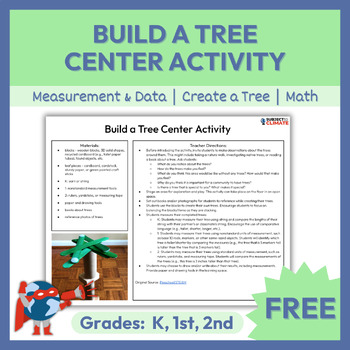Hands-on Measurement & Data Activity for Kindergarten - Gr 2
SubjectToClimate
91 Followers
Grade Levels
K - 2nd
Subjects
Resource Type
Standards
CCSSK.MD.A.1
CCSSK.MD.A.2
CCSS1.MD.A.1
CCSS1.MD.A.2
CCSS2.MD.A.1
Formats Included
- Google Docs™
SubjectToClimate
91 Followers

Made for Google Drive™
This resource can be used by students on Google Drive or Google Classroom. To access this resource, you’ll need to allow TPT to add it to your Google Drive. See our FAQ and Privacy Policy for more information.
Description
In this center activity, K-2 students will design and create a tree using a variety of building materials. The class will explore all things trees, and even take a nature walk if possible, as they participate in this exploration and play activity. Then, use standard and nonstandard units of measurement to practice measuring and comparing skills as you build your own tree!
★ Access Free Resource Here ★
★ What’s Included ★
- Teacher Directions and Materials List
- 3 Printable Color or B&W Leaf Cutout Templates
- 7 Tree Design Reference Pictures
★ Primary Standards ★
Common Core Math Standards (CCSS.MATH)
- Measurement & Data (K-5)
- CCSS.MATH.CONTENT.K.MD.A.1 Describe measurable attributes of objects, such as length or weight. Describe several measurable attributes of a single object.
- CCSS.MATH.CONTENT.K.MD.A.2 Directly compare two objects with a measurable attribute in common, to see which object has "more of"/"less of" the attribute, and describe the difference. For example, directly compare the heights of two children and describe one child as taller/shorter.
- CCSS.MATH.CONTENT.1.MD.A.1 Order three objects by length; compare the lengths of two objects indirectly by using a third object.
- CCSS.MATH.CONTENT.1.MD.A.2 Express the length of an object as a whole number of length units, by laying multiple copies of a shorter object (the length unit) end to end; understand that the length measurement of an object is the number of same-size length units that span it with no gaps or overlaps. Limit to contexts where the object being measured is spanned by a whole number of length units with no gaps or overlaps.
- CCSS.MATH.CONTENT.2.MD.A.1 Measure the length of an object by selecting and using appropriate tools such as rulers, yardsticks, meter sticks, and measuring tapes.
- CCSS.MATH.CONTENT.2.MD.A.4 Measure to determine how much longer one object is than another, expressing the length difference in terms of a standard length unit.
Access this free resource here today so you can teach it tomorrow!
★ More Free Stuff! ★
Total Pages
Answer Key
N/A
Teaching Duration
N/A
Report this resource to TPT
Reported resources will be reviewed by our team. Report this resource to let us know if this resource violates TPT’s content guidelines.
Standards
to see state-specific standards (only available in the US).
CCSSK.MD.A.1
Describe measurable attributes of objects, such as length or weight. Describe several measurable attributes of a single object.
CCSSK.MD.A.2
Directly compare two objects with a measurable attribute in common, to see which object has “more of”/“less of” the attribute, and describe the difference. For example, directly compare the heights of two children and describe one child as taller/shorter.
CCSS1.MD.A.1
Order three objects by length; compare the lengths of two objects indirectly by using a third object.
CCSS1.MD.A.2
Express the length of an object as a whole number of length units, by laying multiple copies of a shorter object (the length unit) end to end; understand that the length measurement of an object is the number of same-size length units that span it with no gaps or overlaps.
CCSS2.MD.A.1
Measure the length of an object by selecting and using appropriate tools such as rulers, yardsticks, meter sticks, and measuring tapes.




